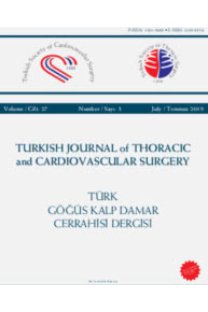Evaluation of polylactide film for prevention of pericardial adhesion in a rabbit model
Perikardiyal adezyonların önlenmesinde polilaktid bariyerin bir tavşan modelinde değerlendirilmesi
___
- 1. Sabik JF 3rd, Blackstone EH, Houghtaling PL, Walts PA, Lytle BW. Is reoperation still a risk factor in coronary artery bypass surgery? Ann Thorac Surg 2005;80:1719-27.
- 2. Yener A, Bardakcı Y, İriz E, Özoğul C, Yener N, Bayram H, et al. Intraoperative changes in the pericardium: a study via electron microscope. Turk Gogus Kalp Dama 2011;4:576-85.
- 3. Nkere UU, Whawell SA, Sarraf CE, Schofield JB, Thompson JN, Taylor KM. Perioperative histologic and ultrastructural changes in the pericardium and adhesions. Ann Thorac Surg 1994;58:437-44.
- 4. Cannata A, Petrella D, Russo CF, Bruschi G, Fratto P, Gambacorta M, et al. Postsurgical intrapericardial adhesions: mechanisms of formation and prevention. Ann Thorac Surg 2013;95:1818-26.
- 5. Orhan A, Görmüş N, Toy H, Görmüş IS, Çağlayan O, Tanyeli Ö. Prevention of retrosternal pericardial adhesions after cardiac surgery with mitomycin C. Heart Lung Circ 2014;23:357-62.
- 6. Alizzi AM, Summers P, Boon VH, Tantiongco JP, Thompson T, Leslie BJ, et al. Reduction of post-surgical pericardial adhesions using a pig model. Heart Lung Circ 2012;21:22-9.
- 7. Colak N, Nazli Y, Alpay MF, Aksoy ON, Akkaya IO, Bayrak R, et al. Effect of topical N-acetylcysteine in the prevention of postoperative pericardial adhesion formation in a rabbit model. Cardiovasc Pathol 2013;22:368-72.
- 8. Naito Y, Shin'oka T, Hibino N, Matsumura G, Kurosawa H. A novel method to reduce pericardial adhesion: a combination technique with hyaluronic acid biocompatible membrane. J Thorac Cardiovasc Surg 2008;135:850-6.
- 9. Shen J, Xu ZW. Combined application of acellular bovine pericardium and hyaluronic acid in prevention of postoperative pericardial adhesion. Artif Organs 2014;38:224-30.
- 10. Mueller XM, Tevaearai HT, Augstburger M, Burki M, von Segesser LK. Prevention of pericardial adhesions with a bioresorbable membrane. Swiss Surg 1999;5:23-6. [Abstract]
- 11. de Oliveira PP, Bavaresco VP, Silveira-Filho LM, Schenka AA, Vilarinho KA, Barbosa de Oliveira Severino ES, et al. Use of a novel polyvinyl alcohol membrane as a pericardial substitute reduces adhesion formation and inflammatory response after cardiac reoperation. J Thorac Cardiovasc Surg 2014;147:1405-10.
- 12. Bel A, Ricci M, Piquet J, Bruneval P, Perier MC, Gagnieu C, et al. Prevention of postcardiopulmonary bypass pericardial adhesions by a new resorbable collagen membrane. Interact Cardiovasc Thorac Surg 2012;14:469-73.
- 13. Kuschel TJ, Gruszka A, Hermanns-Sachweh B, Elyakoubi J, Sachweh JS, Vázquez-Jiménez JF, et al. Prevention of postoperative pericardial adhesions with TachoSil. Ann Thorac Surg 2013;95:183-8.
- 14. Iliopoulos J, Cornwall GB, Evans RO, Manganas C, Thomas KA, Newman DC, et al. Evaluation of a bioabsorable polylactide film in a large animal model for the reduction of retrosternal adhesions. J Surg Res 2004;118:144-53.
- 15. Okuyama N, Rodgers KE, Wang CY, Girgis W, Oz M, St Amand K, et al. Prevention of retrosternal adhesion formation in a rabbit model using bioresorbable films of polyethylene glycol and polylactic acid. J Surg Res 1998;78:118-22.
- 16. Heydorn WH, Daniel JS, Wade CE. A new look at pericardial substitutes. J Thorac Cardiovasc Surg 1987;94:291-6.
- 17. Lu JH, Chang Y, Sung HW, Chiu YT, Yang PC, Hwang B. Heparinization on pericardial substitutes can reduce adhesion and epicardial inflammation in the dog. J Thorac Cardiovasc Surg 1998;115:1111-20.
- 18. Tsukihara H, Takamoto S, Kitahori K, Matsuda K, Murakami A, Novick RJ, et al. Prevention of postoperative pericardial adhesions with a novel regenerative collagen sheet. Ann Thorac Surg 2006;81:650-7.
- 19. Loging JA, New RB, Baicu SC, King MK, Hendrick JW, Crawford FA Jr, et al. Effects of angiotensin type-I receptor blockade on pericardial fibrosis. J Surg Res 1999;87:101-7.
- 20. Mitchell JD, Lee R, Hodakowski GT, Neya K, Harringer W, Valeri CR, et al. Prevention of postoperative pericardial adhesions with a hyaluronic acid coating solution. Experimental safety and efficacy studies. J Thorac Cardiovasc Surg 1994;107:1481-8.
- 21. Krause TJ, Zazanis G, Malatesta P, Solina A. Prevention of pericardial adhesions with N-O carboxymethylchitosan in the rabbit model. J Invest Surg 2001;14:93-7.
- 22. Okuyama N, Wang CY, Rose EA, Rodgers KE, Pines E, diZerega GS, et al. Reduction of retrosternal and pericardial adhesions with rapidly resorbable polymer films. Ann Thorac Surg 1999;68:913-8.
- 23. Schreiber C, Boening A, Kostolny M, Pines E, Cremer J, Lange R, et al. European clinical experience with REPEL- CV. Expert Rev Med Devices 2007;4:291-5.
- 24. Sakuma K, Iguchi A, Ikada Y, Tabayashi K. Closure of the pericardium using synthetic bioabsorbable polymers. Ann Thorac Surg 2005;80:1835-40.
- 25. Gabbay S, Guindy AM, Andrews JF, Amato JJ, Seaver P, Khan MY. New outlook on pericardial substitution after open heart operations. Ann Thorac Surg 1989;48:803-12.
- ISSN: 1301-5680
- Yayın Aralığı: 4
- Başlangıç: 1991
- Yayıncı: Bayçınar Tıbbi Yayıncılık
Torakotomiyi kapamada yeni ve avantajlı bir alternatif yöntem var mıdır?
Ozan Onur BALKANAY, Gökhan İPEK, Deniz GÖKSEDEF, Suat Nail ÖMEROĞLU, Zeki KILIÇ, Safa GÖDE
Dev mediastinal kitlenin koil embolizasyonu sonrası tam rezeksiyonu: Olgu sunumu
Tamer OKAY, Sinan ŞAHİN, Ufuk ÇİLOĞLU, Sabri DAĞSALI, Ekin İLKELİ, Şebnem ALİBEYOĞLU
Radio-medyan cubital arteriovenous fistula creation for hemodialysis access
Seyhan YILMAZ, Serdar GÜNAYDIN, Eray AKSOY
Nihan EREN KAHYA, Sadık Volkan EMREN, Hale BÜlBÜL, Sadettin USLU, Serhan ÖZYILDIRIM
Selen ÖZTÜRK, İbrahim ÖZTÜRK, Seher İLHAN, Alper ÖZGÜR
Prosthetic valve endocarditis after transcatheter aortic valve implantation
Kemal ERDOĞAN, Tahir DURMAZ, Hüseyin BAYRAM, Abdülkadir BİLGİÇ, Erol ŞENER, Mete HIDIROĞLU, Aslıhan KÜÇÜKER
Multidetector computed tomography evaluation of aortic arch and branching variants
Mehmet Salih AYDIN, Aydemir KOCARSLAN, Hasan CECE, Sema YILDIZ, Ekrem KARAKAŞ, Nurefşan BOYACI, Dilek Şen DOKUMACI
Ozan ERBASAN, Nursel ŞAHİN, Hanife KABUKCU, Tülin TİTİZ AYDOĞDU
Berker ÖZKAN, Adalet DEMİR, Suat ERUS, Sedat ZİYADE, Murat KAPDAĞLI, Serhan TANJU, Başak SARAÇOĞLU, Erkan KABA, Alper TOKER
